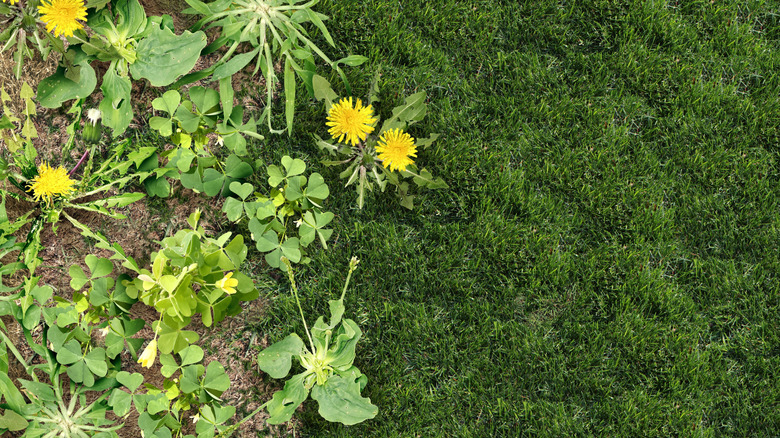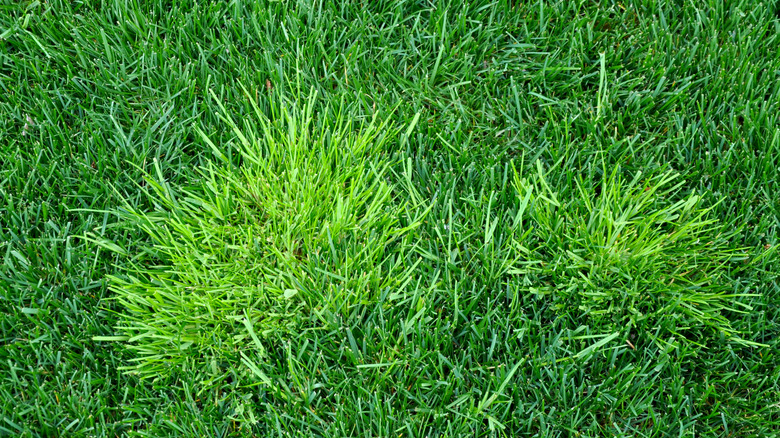The Two Types Of Weeds You'll Find In The Yard During Winter (& How To Get Rid Of Them)
When winter comes, most plants and many grasses go dormant. It's like they are taking a break. And while it is easy to assume you can also relax and skip yard care for a while, it is rarely true. The cold weather brings along its own trouble as it invites winter weeds to grow and spread. And there are a lot of sneaky weeds that can wreak havoc on your yard during winter that sprout in late fall and grow during the cold season. If you don't remove them, they will compete with your desired plants, leaving them struggling next season. Generally, these winter weeds can be divided into two types: broadleaf weeds and grassy weeds.
As the name suggests, broadleaf weeds have wide leaves. They emerge from the ground with two seed leaves (cotyledons), have net-like veins, and some even have showy flowers. In contrast, grassy weeds have narrow, grass-like blades with parallel veins, and they sprout with a single cotyledon from the ground. But why is the difference important? That is because most herbicides strike either broadleaf or grassy weeds, but not both. Therefore, correct identification is the key here; it helps you decide which control methods to use and when to use them.
Common broadleaf weeds and how to get rid of them?
Most broadleaf weeds do not pose a significant problem if the grass and plants in your yard are well established. However, if they find a weakness, they will invade. That is where knowing how to identify and get rid of broadleaf weeds in your yard can make a difference. Common examples of winter broadleaf weeds include chickweed (Stellaria media), common vetch (Vicia sativa), henbit (Lamium amplexicaule) and hairy bittercress (Cardamine hirsuta).
When it comes to controlling broadleaf weeds, the most commonly used herbicides include 2,4-DP or DPC (Dichloprop), MCPP (mecoprop), 2,4-D, and Banvel (dicamba). Hand weeding can also work if there are only a few and the area is small. Just grab them from the base where the stems meet and pull up to remove the entire mat cleanly. If you would, however, like to solve the problem before it even begins, pre-emergent herbicides are also an option.
Most pre-emergent herbicides stay effective for six to 12 weeks. For best results, apply them in the fall, when nighttime temperatures linger between 55 and 60 degrees Fahrenheit for four straight days, as that is when winter weeds are ready to stir. And as always, read the label before using any herbicide.
Common grassy weeds and how to get rid of them?
Grassy weeds can be tricky to recognize, and even when you do, they are hard to get rid of. You have to be able to tell if the grass in your lawn is actually a problem, as they hide in plain sight, mingling with your real grass. You usually only notice them when it is too late, and they have built thick, stubborn colonies beneath your feet. Common examples of winter grassy weeds include ryegrass (Lolium multiflorum), rescuegrass (Bromus catharticus), cheatgrass (Bromus tectorum) and annual bluegrass (Poa annua). Regardless of what you have, when it comes to controlling grassy winter weeds, you can use pronamide shortly after they start emerging in October or November.
You can also try using non-selective herbicides. Examples include glyfosinate and glyphosate. Use them as a spot treatment for small patches, but keep in mind that they will kill all vegetation in the area because of their non-selective nature. Other than knowing which herbicide to use, it is also important to know the type of turf you are going to apply it to, as not all grassy weed herbicides can be applied to all turf in the yard. Therefore, make sure you read the label and follow the instructions before use.


